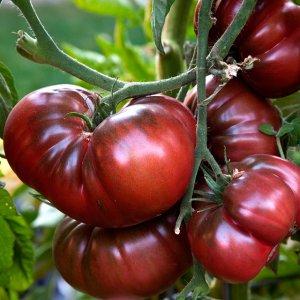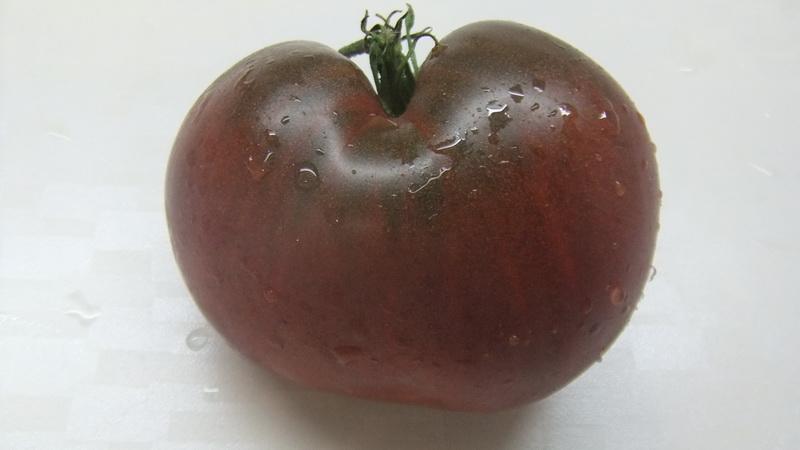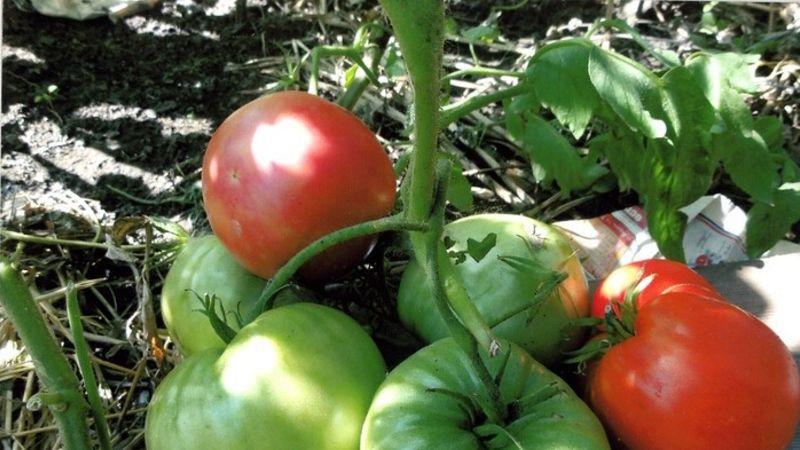How to grow a Black Elephant tomato
Everyone is accustomed to the fact that the color of tomatoes varies from light pink to deep red, so unusual color options are of interest. In particular, this applies to black tomatoes. Such fruits immediately attract attention. Will they taste as unusual?
In this article, you will learn interesting and useful information about one of these varieties - tomato "Black Elephant".
The content of the article
Characteristics and description of the variety
The name "black" is a bit exaggerated for this variety. Fruit color is red-brown with a green tint when ripe... The dark spot is concentrated at the peduncle. The fruits of this variety can be distinguished not only by color, but also by their flat rounded shape.

The weight of a ripe fruit is usually 200-300 g, but in some cases it reaches 400 g. Plants have large green leaves, similar in shape and size to potato ones. Bushes are medium-high: about 160 cm. Productivity is high: average value - 4 kg, but can reach 9 kg per 1 sq. M.
“Black Elephant” is known for its unusual taste. Ripe tomatoes are juicy and fleshy. A large amount of sugar makes the fruit sweet, with a sour tart aftertaste.
The black elephant is consumed both fresh and after processing.
Advantages and disadvantages
Like any variety, Black Elephant has advantages and disadvantages.
Pros:
- Original color. Thanks to this shade, any dish with "Black Elephant" will look fresh and interesting.
- An unusual taste combining sweetness and acidity.
- High productivity.
- The tomato grows both in greenhouse conditions and in the open field (but only in the southern territories of the country).
- It can be used not only fresh and in salads, but also processed into ketchup or juices, preserving its great taste.
Minuses:
- Plants require careful leaving: pinching, shaping and thinning bushes
- Not resistant to late blight (one of the most common plant diseases).
- Ripe fruits are not stored for a long time.
Rules for growing tomatoes "Black Elephant"
Despite the fact that this grade relatively unpretentious, it is important to follow some rules in order to grow high-quality and tasty vegetables.
First you need to prepare the seedlings. This is done in the first decade of March. Tomato seeds are soaked in a solution of potassium permanganate before planting... This disinfects them. For the same purpose, you can pour boiling water over the prepared soil.
The soil is suitable for both purchased and prepared independently. Such soil should include humus, peat, baking powder in the form of sand or sawdust, and leafy soil to increase the nutritional value of the material. The composition may differ slightly from the one suggested. The main thing is that the soil is loose and nutritious.
The prepared seeds are sown in soil-filled seedling boxes. They are planted in depressions of 1-2 cm, the gap between them should not exceed 2 cm.Trenches from the depressions are placed at a distance of 3-4 cm. Sprinkle the seedlings with soil, and cover the finished seedlings with foil or cover with glass to keep warm. Place the boxes in a warm place with a temperature of 25-26 degrees.
When the first shoots appear, it is important to provide the seedlings with plenty of light. It is transferred to the greenhouse in May-June. It depends on the air temperature: if the temperature does not drop below 10 degrees at night, it is time to transplant.

Transplanting the "Black Elephant" into the greenhouse, they are guided by several rules:
- the depth of the planting holes must be at least 35 cm;
- the distance between the bushes should be at least 50 cm so that the plant can develop freely, and the gardener can take care of it;
- distance between rows - 1 m;
- when planting, a support is immediately placed near each bush so that the seedling is formed correctly during the period of active growth.
Water the tomatoes at the root on average 1 time per 10 days. The frequency of watering depends on how hot the summer is, how quickly the soil is drained. It is important to weed after watering so the soil can absorb water faster and more efficiently.
Feed plants can be fertilized with both mineral and organic fertilizers until the fruit appears. It is also recommended to cover the soil with mulch (chopped grass) to retain moisture.
We must not forget about pinching the bushes. This is the name of the removal of excess shoots from plants, so that nutrients are directed not to growth, but to the formation of fruits. Formation of 2-3 stems is allowed. We must not forget about thinning the foliage, in particular the lower one, since the water that lingers on them, during evaporation, causes burns in the plant. For the same reason, tomatoes are watered not by sprinkling, but at the root.
Important! Remember to ventilate the greenhouse and provide sufficient light for the tomatoes to prevent fungus and rot.
If you follow all the rules, then already on the 60th day from the moment of disembarkation in the greenhouse or open ground "Black Elephant" will delight you with ripe fruits. It is important to regularly harvest the ripe fruit so that it does not rot.
Prevention of diseases and pests
The black elephant is susceptible to many diseases and the influence of pests, therefore it requires careful care.
To prevent fungal growth, treat the bushes with antifungal agents weekly. For prevention, medicinal preparations are suitable. In addition, do not neglect airing the greenhouse, mulching the soil, as well as pinching and thinning the bushes.
Diseases characteristic of the Black Elephant variety
Late blight. A common disease that manifests itself in the formation of dark spots on the fruits and leaves of plants. The whole plant is affected and the tomatoes are no longer suitable for consumption.
Prevention of late blight consists, first of all, in careful care of plants in order to increase its immunity. In addition, you need to isolate tomatoes from other plants susceptible to this disease (in particular, potatoes). In autumn, do not forget to collect all plant residues, and in spring - carefully dig up the soil.
The fight against the disease consists in the immediate removal of damaged fruits and shoots and treatment of the plant with drugs against late blight. Chemicals are most effective, but if the plant is already bearing fruit, then it is better to stop at biological products.
Verticillary wilting affects the leaves of the bush. They begin to turn yellow, curl, but do not die, thereby inhibiting the development of the plant.
This disease is classified as fungal. There are no effective drugs to combat it, therefore, special attention is paid to prevention. It consists in sterilizing the soil before planting, as well as carefully caring for the plant. If the tomato is still infected, the bush must be urgently pulled out and burned.
Femoz provokes the formation of brown spots on the fruits, and subsequently - their rotting.
Prevention of this disease also consists in careful plant care. The tomato should be fed with nitrogen and organic fertilizers, but you cannot overdo it with them. If you notice signs of the disease, you need to deal with it with special drugs or medicine based on copper oxychloride. If remedial measures do not help, then the infected plant must be immediately removed and burned.

Streak expressed as small yellow stripes on the plant. It causes shedding of flowers and shoots.
Methods for combating streakiness are to disinfect the seeds before planting seedlings.After the seedlings, it is necessary to water with a solution of potassium permanganate 2-3 times with an interval of 3 weeks. The planted plants are fed with a solution of succinic acid 4 times: after the pick, when the plant has taken root, and then after 10, 20 and 30 days.
The affected plant should also be removed.
In addition, the "Black Elephant" is exposed to the invasion of insects: whitefly, slugs, bear, spider mite, gnawing scoops, wireworm. The best method of control is mechanical collection of insects, so as not to use chemistry again. Insecticides (against insects) can only be used before fruit appears.
Reviews
Marina H., Kaliningrad: «Gorgeous grade. Super reliable. It bears excellent fruit both in the greenhouse and in the open field. The taste is very good, although not too sweet, with sourness. The juice from it is good, but I add red varieties, because not very pretty. I have been planting for many years already as a cultivar».
Nataly, Moscow: «I planted the Black Elephant variety for the first time last season. I liked it very much! The most delicious was (we tasted Watermelon, Brown sugar and it)».
Maria, Smolensk: “I love this variety very much! I plant it every year. Grows in a greenhouse up to 1.5 m, very productive. Resistant to any weather disasters, healthy. I also like the taste, although I like sweet tomatoes, and the Black Elephant with sourness, but it has an unusual taste, I can't even describe it. The salad is juicy and meaty, what you need».
Conclusion
"Black Elephant" is an exotic tomato variety. Differs in productivity and unusual taste. It requires careful maintenance, as it is susceptible to diseases and pests. Therefore, if you decide grow this variety in your area, carefully read the rules for caring for this unusual plant.